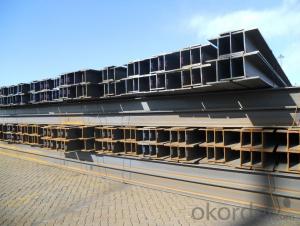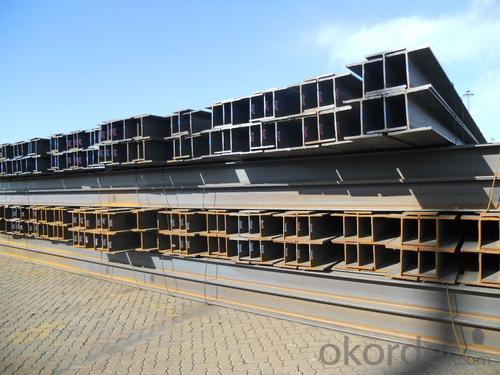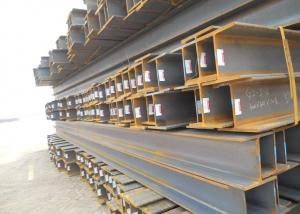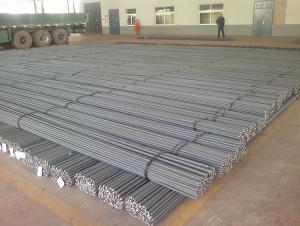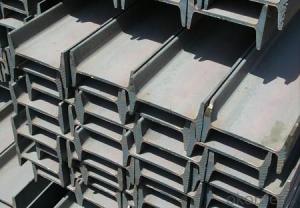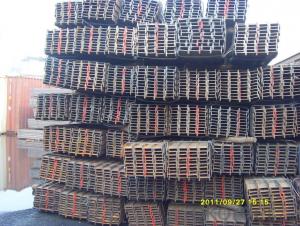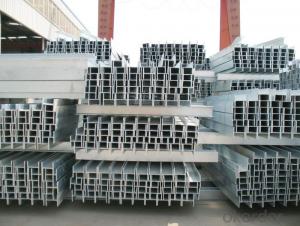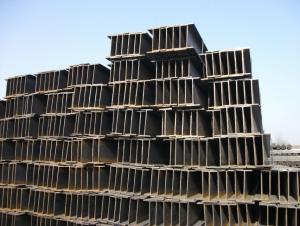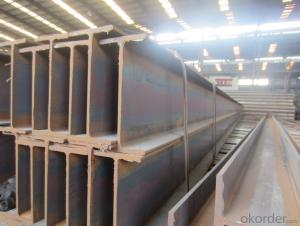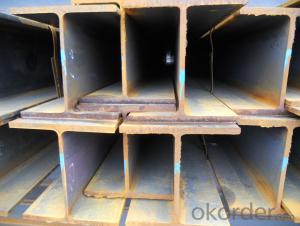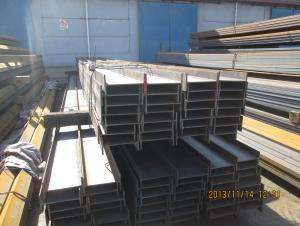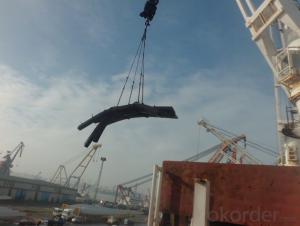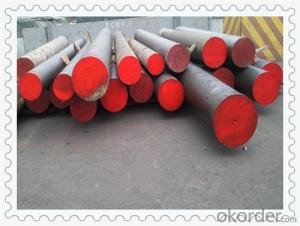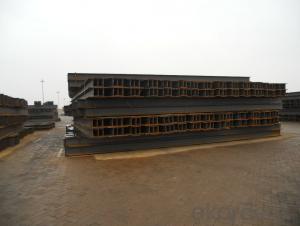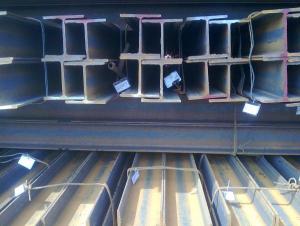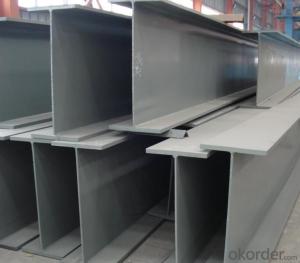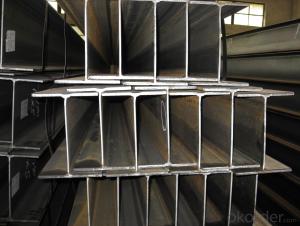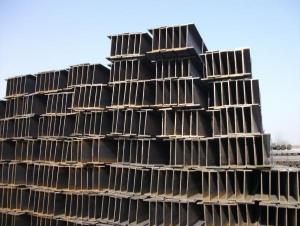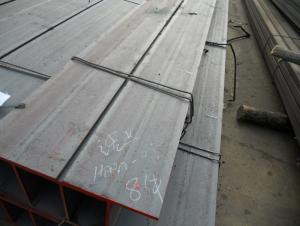Structual Carbon Steel Hot Rolled H-beam Bar
- Loading Port:
- China main port
- Payment Terms:
- TT or LC
- Min Order Qty:
- 25 m.t.
- Supply Capability:
- 1000 m.t./month
OKorder Service Pledge
OKorder Financial Service
You Might Also Like
Product Description:
OKorder is offering high quality Hot Rolled Steel I-Beams at great prices with worldwide shipping. Our supplier is a world-class manufacturer of steel, with our products utilized the world over. OKorder annually supplies products to European, North American and Asian markets. We provide quotations within 24 hours of receiving an inquiry and guarantee competitive prices.
Product Applications:
Commercial building structure ;Pre-engineered buildings; Machinery support structure; Prefabricated structure; Medium scale bridges; Ship-building structure.etc.
Product Advantages:
OKorder's Steel I-Beams are durable, strong, and resist corrosion.
Main Product Features:
· Premium quality
· Prompt delivery & seaworthy packing (30 days after receiving deposit)
· Corrosion resistance
· Can be recycled and reused
· Mill test certification
· Professional Service
· Competitive pricing
Product Specifications:
Manufacture: Hot rolled
Grade: Q195 – 235
Length: 6m – 12m, as per customer request
Packaging: Export packing, nude packing, bundled
H x B
(mm)
| T1 | T2 | JIS Weight
(kg/m)
| GB Weight
(kg/m)
|
100*100 | 6 | 8 | 16.9 | 17.2 |
125*125 | 6.5 | 9 | 23.6 | 23.8 |
150*75 | 5 | 7 | 14 | 14.3 |
148*100 | 6 | 9 | 20.7 | 21.4 |
150*150 | 7 | 10 | 31.1 | 31.9 |
175*90 | 5 | 8 | 18 | 18.2 |
175*175 | 7.5 | 11 | 40.4 | 40.4 |
198*99 | 4.5 | 7 | 17.8 | 18.5 |
200*100 | 5.5 | 8 | 20.9 | 21.7 |
194*150 | 6 | 9 | 29.9 | 31.2 |
200*200 | 8 | 12 | 49.9 | 50.5 |
248*124 | 5 | 8 | 25.1 | 25.8 |
250*125 | 6 | 9 | 29 | 29.7 |
244*175 | 7 | 11 | 43.6 | 44.1 |
250*250 | 9 | 14 | 71.8 | 72.4 |
298*149 | 5.5 | 8 | 32 | 32.6 |
298*201 | 9 | 14 | 65.4 | |
300*150 | 6.5 | 9 | 36.7 | 37.3 |
294*200 | 8 | 12 | 55.8 | 57.3 |
300*300 | 10 | 15 | 93 | 94.5 |
346*174 | 6 | 9 | 41.2 | 41.8 |
350*175 | 7 | 11 | 49.4 | 50 |
340*250 | 9 | 14 | 78.1 | 79.7 |
350*350 | 12 | 19 | 135 | 137 |
400*200 | 8 | 13 | 65.4 | 66 |
390*300 | 10 | 16 | 105 | 107 |
400*400 | 13 | 21 | 172 | 172 |
446*199 | 8 | 12 | 65.1 | 66.7 |
450*200 | 9 | 14 | 77.9 | 79.5 |
440*300 | 11 | 18 | 121 | 124 |
496*199 | 9 | 14 | 77.9 | 79.5 |
500*200 | 10 | 16 | 88.2 | 89.6 |
488*300 | 11 | 18 | 125 | 129 |
596*199 | 10 | 15 | 92.5 | 95.1 |
600*200 | 11 | 17 | 103.4 | 106 |
588*300 | 12 | 20 | 147 | 151 |
700*300 | 13 | 24 | 182 | 185 |
800*300 | 14 | 26 | 207 | 210 |
900*300 | 16 | 28 | 240.1 | 243 |
Payment:
-Invoicing on theoretical weight or actual weight as customer’s request.
-FOB, CFR or CIF.
-Regular terms of payment:
1, 30% payment in advance, the remaining balance (70% payment) against the copy of B/L. 100% payment before shipment.
2, 30% payment in advance, the remaining balance (70% L/C) against the copy of B/L. 100% payment before shipment.
3, Negotiable.
FAQ:
Q1: Why buy Materials & Equipment from OKorder.com?
A1: All products offered byOKorder.com are carefully selected from China's most reliable manufacturing enterprises. Through its ISO certifications, OKorder.com adheres to the highest standards and a commitment to supply chain safety and customer satisfaction.
Q2: What makes stainless steel stainless?
A2: Stainless steel must contain at least 10.5 % chromium. It is this element that reacts with the oxygen in the air to form a complex chrome-oxide surface layer that is invisible but strong enough to prevent further oxygen from "staining" (rusting) the surface. Higher levels of chromium and the addition of other alloying elements such as nickel and molybdenum enhance this surface layer and improve the corrosion resistance of the stainless material.
Q3: Can stainless steel rust?
A3: Stainless does not "rust" as you think of regular steel rusting with a red oxide on the surface that flakes off. If you see red rust it is probably due to some iron particles that have contaminated the surface of the stainless steel and it is these iron particles that are rusting. Look at the source of the rusting and see if you can remove it from the surface.
Images:
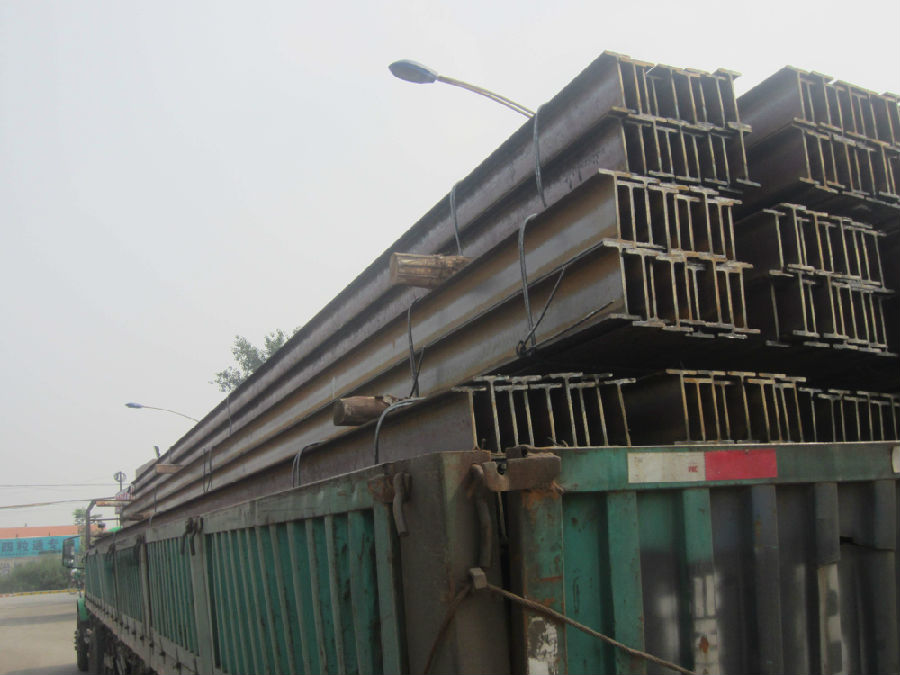
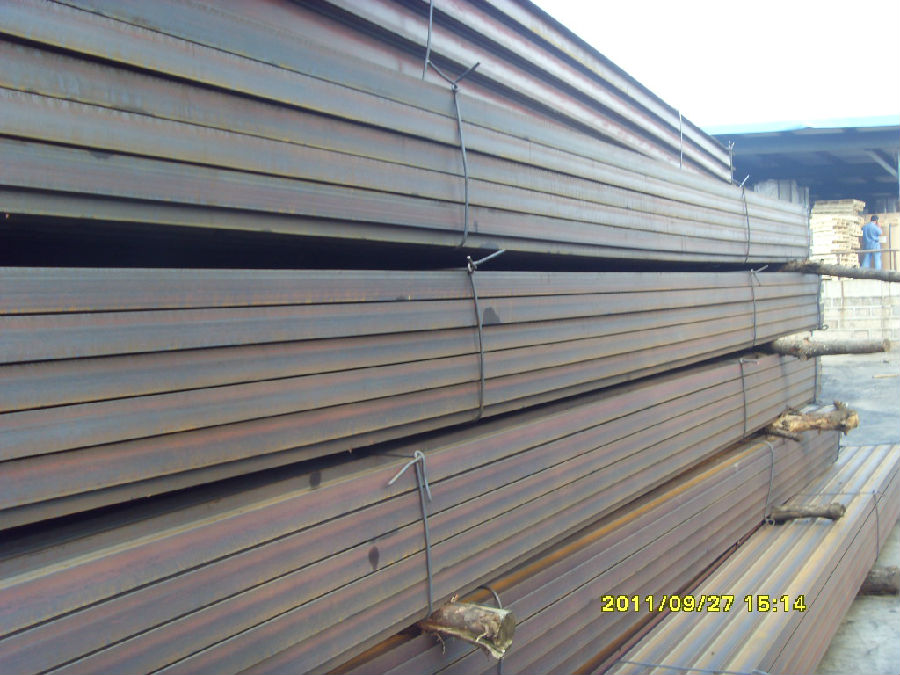
- Q: Can steel H-beams be used in underground parking structures?
- Indeed, underground parking structures can indeed utilize steel H-beams. Due to their robustness and endurance, steel H-beams are frequently employed in construction. These beams possess the capability to bear substantial loads and endure the immense pressure exerted by the weight of the structure positioned above. Given the restricted nature of space in underground parking structures, steel H-beams are widely favored as they offer a commendable strength-to-weight ratio, thereby enabling efficient utilization of space. Furthermore, the fabrication and installation of steel H-beams are hassle-free, rendering them a sensible and economically viable choice for underground parking structures.
- Q: What are the common welding techniques used for steel H-beams?
- Steel H-beams can be welded using various techniques, including shielded metal arc welding (SMAW), gas metal arc welding (GMAW), and submerged arc welding (SAW). SMAW, also known as stick welding, is a hands-on process where a welder holds a flux-coated electrode and feeds it continuously into the joint. This technique is ideal for on-site construction or repair work due to its versatility and accessibility. GMAW, or MIG welding, is a semi-automatic or automatic process that utilizes a continuous wire electrode and shielding gas. The wire passes through a welding gun, creating an electric arc with the workpiece. This arc melts the wire, fusing it with the base metal. GMAW is widely used in structural steel fabrication for its efficiency and ability to weld thicker materials. SAW is an automatic process that involves a continuous wire electrode and a granular flux covering the weld area. The arc is submerged beneath the flux, creating a protective environment and preventing spatter formation. SAW is commonly used for welding heavy sections like steel H-beams due to its high deposition rate and deep penetration capabilities. Apart from these primary techniques, other methods such as flux-cored arc welding (FCAW) and laser beam welding (LBW) can also be employed for steel H-beams, depending on project-specific requirements and constraints. It is crucial to select the appropriate welding technique considering factors like joint design, material thickness, and desired weld quality to ensure a successful and structurally sound weld.
- Q: What are the common safety precautions when working with steel H-beams?
- Common safety precautions when working with steel H-beams include wearing appropriate personal protective equipment (PPE) such as hard hats, steel-toed boots, safety glasses, and gloves to protect against potential hazards. It is crucial to ensure proper lifting techniques and use of equipment such as cranes or forklifts to prevent accidents due to heavy loads. Additionally, workers should be cautious about potential tripping hazards and maintain a clean and organized workspace. Regular inspections of the beams for any damage or defects should be conducted, and workers should be trained on proper procedures for cutting, welding, or handling the steel beams to minimize the risk of accidents or injuries.
- Q: Can steel H-beams be used in the construction of government or municipal buildings?
- Absolutely, government or municipal buildings can certainly utilize steel H-beams in their construction. Due to their exceptional strength, durability, and versatility, steel H-beams are widely employed within the construction industry. They offer excellent structural support and possess the ability to endure heavy loads, rendering them appropriate for a range of building types, including government or municipal buildings. Government or municipal buildings often necessitate expansive open spaces, lengthy spans, and robust structural systems in order to accommodate various functions and activities. Steel H-beams provide the necessary strength and stability to fulfill these requirements. They can be employed as columns, beams, or trusses, thereby creating a resilient framework for the structure of the building. Moreover, steel H-beams boast remarkable flexibility in terms of design and can be easily fabricated to meet specific architectural and structural demands. This empowers architects and engineers to fashion distinctive and visually appealing government or municipal buildings while upholding structural integrity. Additionally, steel H-beams possess numerous advantages over alternative construction materials. They possess fire-resistant and non-combustible properties, and can withstand harsh weather conditions, making them ideal for government or municipal buildings that prioritize safety and durability. In conclusion, steel H-beams represent a practical and efficient choice for the construction of government or municipal buildings. Their strength, durability, design flexibility, and resilience against fire and extreme weather conditions all contribute to their reliability in creating safe and long-lasting structures.
- Q: Can steel H-beams be used in temporary structures or scaffolding?
- Yes, steel H-beams can be used in temporary structures or scaffolding. Their strong and durable construction makes them suitable for supporting heavy loads and providing stability in temporary applications.
- Q: H steel column calculationHow do you calculate the amount? And what are the steps and formulas for this calculation?
- H steel is welded; HWHMHN is the hot rolled HW H steel is the height and width of flange is basically the same; mainly used for reinforced concrete frame column steel column, also known as rigid steel column; in steel structure is mainly used for HM H type steel column height and wing
- Q: What are the requirements for steel H-beams in hurricane-prone regions?
- To ensure the safety and structural integrity of buildings and structures in hurricane-prone regions, steel H-beams must meet specific criteria. These criteria are designed to withstand the high wind speeds and potential impact from debris that hurricanes can bring. One of the main requirements for steel H-beams in hurricane-prone regions is their need for high strength and durability. These beams must be capable of resisting the powerful forces exerted by hurricane winds, which can reach speeds exceeding 150 miles per hour. This typically involves using high-grade steel with a high yield strength and tensile strength, ensuring the beams can withstand wind pressure and avoid structural failure. Another important factor to consider is the design and shape of the H-beams. The shape of the beam, including its flanges and web, helps distribute the load and provide stability. In hurricane-prone regions, H-beams with wider flanges and thicker webs are often preferred as they offer better resistance to bending and torsion forces caused by high winds. The design should also consider factors such as appropriate depth and width to provide optimal strength and stability. In addition to material and design, the installation and connection of steel H-beams in hurricane-prone regions must also meet specific requirements. The connections between beams and other structural elements must be robust and able to withstand the dynamic forces generated by hurricane winds. Welding or bolting techniques must be utilized to ensure a strong and secure connection capable of withstanding the lateral and uplift forces associated with hurricanes. Lastly, adherence to building codes and regulations is crucial in hurricane-prone regions. Local building codes often provide specific guidelines for the use of steel H-beams in these areas, including minimum design loads, wind speed requirements, and installation techniques. It is important to consult with local authorities and engineers knowledgeable in hurricane-resistant design to ensure compliance with all relevant codes and regulations. Overall, the requirements for steel H-beams in hurricane-prone regions revolve around strength, durability, appropriate design, secure connections, and compliance with building codes. By meeting these requirements, steel H-beams can contribute to the construction of resilient buildings and structures capable of withstanding the destructive forces of hurricanes.
- Q: How do steel H-beams perform in snow-prone areas?
- Steel H-beams perform well in snow-prone areas due to their high strength and load-bearing capacity. The structural integrity of H-beams allows them to withstand heavy snow loads without significant deflection or failure. Additionally, the smooth surface of steel beams prevents snow accumulation, reducing the risk of roof collapse. Overall, steel H-beams are a reliable choice for snow-prone areas, ensuring safety and durability in challenging winter conditions.
- Q: Are there any limitations on the length of steel H-beams?
- Yes, there are limitations on the length of steel H-beams. The length of H-beams is typically limited by the manufacturing capabilities and transportation logistics. In terms of manufacturing, the size and weight of the H-beam can affect the length that can be produced. Larger and longer H-beams may require specialized manufacturing equipment and processes, which may not be readily available. Transportation logistics also play a role in the length limitation. H-beams are typically transported by truck or rail, and there are restrictions on the maximum length that can be transported without obtaining special permits. These restrictions are imposed by local regulations and transportation authorities to ensure safe and efficient transportation. In addition, longer H-beams may be more prone to bending or warping during handling and installation, which can affect their structural integrity. Therefore, there may be practical limitations on the length of steel H-beams based on these considerations. It is important for architects, engineers, and manufacturers to assess the specific project requirements and limitations when determining the appropriate length of steel H-beams to ensure safety, efficiency, and compliance with regulations.
- Q: How do steel H-beams contribute to green roof design?
- Steel H-beams contribute to green roof design by providing a strong and durable framework to support the weight of the green roof system. These beams are typically made from recycled steel, promoting sustainability. Additionally, their structural integrity allows for the installation of extensive green roofs, which help to reduce stormwater runoff, improve air quality, and enhance energy efficiency in buildings.
Send your message to us
Structual Carbon Steel Hot Rolled H-beam Bar
- Loading Port:
- China main port
- Payment Terms:
- TT or LC
- Min Order Qty:
- 25 m.t.
- Supply Capability:
- 1000 m.t./month
OKorder Service Pledge
OKorder Financial Service
Similar products
Hot products
Hot Searches
Related keywords
